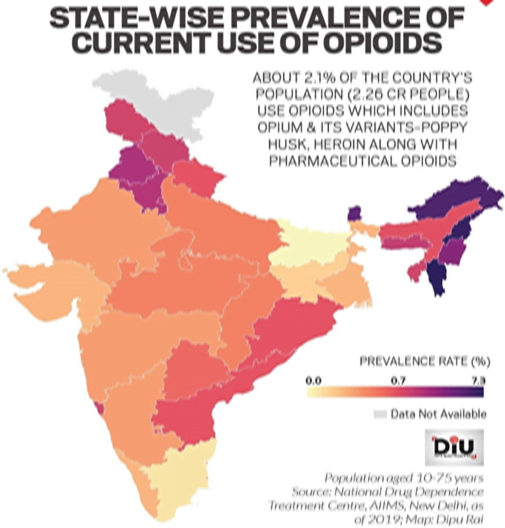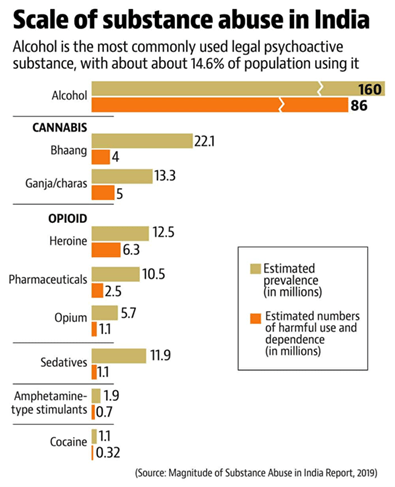Governance
In News: The death of two brothers due to drug addiction on the same day in Punjab’s Amritsar and a viral video of drug abuse inside a jail where one of the brothers was lodged has put the focus back on the drug menace in the state.
- This is the second such case of brothers dying due to alleged drug addiction in the Majha region in the last two months
Understanding the situation:
- Globally, the prevalence of alcohol use disorders is significantly higher than the prevalence of drug use disorders.
- Generally, alcohol and drug use disorders are more common among males than among females.
- According to the World Health Organisation Report 2002 (WHO), 8.9% of the total burden of disease is due to use of psychoactive substances; tobacco accounted for 4.1%, alcohol 4%, and illicit drugs 0.8% of the burden of disease.
- There are 2 billion alcohol users, 1.3 billion smokers and 185 million drug users globally (WHO 2002).
- These three psychoactive substances have different disease burden on different age groups.
- Illicit drug use causes mortality earliest in life, alcohol also mainly (65%) before the age of 60, while 70% of the tobacco deaths occur after the age of 60.
- The use of different substances varies in different WHO regions as in Europe and South-East Asia tobacco use is the largest burden while alcohol is the largest burden in Africa, the Americas, and Western Pacific.
- 155 to 250 million people, or 3.5% to 5.7% of world’s population aged 15-64 used other psychoactive substances, such as cannabis, amphetamines, cocaine, opioids, and non-prescribed psychoactive prescription medication (WHO-2008).
- Globally, cannabis is the most commonly used substance (129-190 million people), followed by amphetamine type stimulants, then cocaine and opioids.
Indian Context:
- In India, opioids are commonly used including heroin (‘smack’ / ‘brown sugar’) as well as pharmaceutical opioids (such as buprenorphine, pentazocine and dextro-propoxyphene).
- In the north-eastern region, heroin and dextropropoxyphene are the most commonly used opioids
- Impure heroin (smack), and buprenorphine are the most commonly used opioids in metropolitan cities such as Delhi, Mumbai, Chennai and Kolkata.
- Pentazocine is the most commonly injected opioid in Karnataka, Andhra Pradesh, Chattisgarh.
- In the states of Punjab and Haryana, buprenorphine is commonly used by injectors.
- As per the HIV sentinel surveillance report, HIV prevalence among IDUs in India is 7.2%. However, some states have much higher HIV rates among IDUs such as HIV prevalence among IDUs is 21% in Punjab, 18% in Delhi and around 12% in Manipur and Mizoram.


Causes:
- Genetics & Family History – Your genes may mean a greater predisposition to addiction. If your parents or their parents had a history with drug abuse, your chances of being addicted to drugs increase drastically.
- Environmental Cause – As environment influences behaviour, it can contribute to drug addiction
- Abuse of drugs among friends and peers
- Lack of social support
- Troubled relationships
- Stress in life
- Low socioeconomic status
- Psychological Cause such as sexual or physical abuse, negligence from parents and peers, domestic violence, everything can lead to psychological stress. And people turn to drugs to let off this stress. Over time, this misuse of drugs can become an addiction.
- Other psychological causes
- Mental disorder such as depression
- Lack of friends in school or any social setting
- Huge academic pressure
- Traumatic events
- Glorification in popular media like television series, films picturises it as a thrilling and seductive affair for youngsters who can be misguided easily because of their relative lack of experience in life.
- Lack of knowledge of risk factors related to drug abuse.
Concerns:
- People who inject drugs (psychoactive drugs for non-medical purposes) are at increased risk of HIV, hepatitis B and hepatitis C.
- Around 13 million people inject drugs globally and 1.7 million of them are living with HIV; injecting drug user accounts for approximately 10% of HIV infections.
- The estimated global prevalence of hepatitis C in people who inject drugs is 67%.
- Psychoactive substance use by drivers has been associated with impaired driving and increased accidents risk.
- Health and social problems associated with use of and dependence on tobacco, alcohol and illicit substances can be prevented by greater awareness by individuals, families and societies to use appropriate public health actions.
Suggestions:
- Knowledge and Education: learning about the physical, biological, and social effects of drug misuse and evaluating the risk factors like losing a job, isolation from society, dropping out of college.
- Developing a healthy lifestyle: There is no better prevention of drug problems than adopting a healthy lifestyle. Being active and fit makes it easier to manage stress. This, in turn, helps to reduce the urge to use drugs or any other harmful substances to manage stress.
- Behavioural Therapy: is the standard treatment for drug addiction after detoxification. It can be done by one-on-one sessions, in a group, or family basis, depending on the requirements.
- Learning healthy ways to cope with stress – Stress is one of the primary reasons that drive people to drug misuse. In this fast-paced world, stress is inevitable. Healthy habits like exercising, volunteering for a good cause, etc. to increase sense of fulfilment.
- Developing close bonds with family: A loving family works as a support system and helps you deal with your pressures in life.
Government initiatives:
- Nasha Mukt Bharat: Annual Action Plan (2020-21)
- three-pronged attack combining efforts of Narcotics Bureau, Outreach/Awareness by Social Justice and Treatment through the Health Dept.
- The Action Plan has the following components: Awareness generation programmes; Focus on Higher Educational institutions, University Campuses and Schools; Community outreach and identification of dependent population; Focus on Treatment facilities in Hospital settings; and Capacity Building Programmes for Service Provider.
- National Action Plan for Drug Demand Reduction for the period of 2018-25 prepared by The Ministry of Social Justice and empowerment
- Preventive education
- Awareness generation
- Identification, counselling, treatment and rehabilitation of drug dependent persons
- Training and capacity building of service providers through collaborative efforts of government and civil society
Way forward:
- Though the government has an over-encompassing blueprint, committed workforce and several dedicated programmes and policies at its disposal, there is a need to improve the current programmes (to address the unmet needs), to have a coordinated effort between Ministries, incurring uniformity at the policy level, to make scientifically informed choices and to strengthen the supply reduction chains.
Heroine:
- Heroin is an opioid drug made from morphine, a natural substance taken from the seed pod of the various opium poppy plants grown in Southeast and Southwest Asia, Mexico, and Colombia.
- Heroin can be a white or brown powder, or a black sticky substance known as black tar heroin.
- People inject, sniff, snort, or smoke heroin. Some people mix heroin with crack cocaine, a practice called speed balling.
- Heroin enters the brain rapidly and binds to opioid receptors on cells located in many areas, especially those involved in feelings of pain and pleasure and in controlling heart rate, sleeping, and breathing.
- People who use heroin report feeling a “rush” (a surge of pleasure, or euphoria)
- However, there are other common effects, including: heavy feeling in the arms and legs, nausea and vomiting, clouded mental functioning and being unconscious.
- Long term effects may include liver and kidney diseases, infection of the heart lining and valves, abscesses, mental disorders such as depression, etc.
Source: Indian Express














